Trash baskets and sediment buckets are extremely useful components of a drainage system. They create a point where debris and sediment can be collected. This keeps foreign material from entering the piping system. While the selection of a trash basket or sediment bucket is often overlooked, it is a vital decision that will affect drainage performance, maintenance, and overall life cycle costs of the drainage system.
Trash baskets, Sediment Buckets, Screens & Strainers
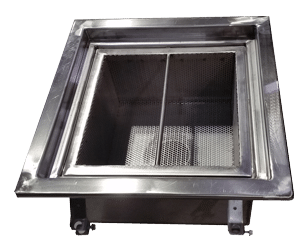
What is the Difference in a "Trash Basket", "Sediment Bucket", "Screen", and "Strainer"?
Many people and even other drainage companies use all of these terms somewhat interchangeably. This often starts because they only offer limited options. Dura Trench believes that this is a big mistake. We know these are different to engineers who know. Here is the difference…
- A trash basket is meant to capture floating trash and debris. This material is typically strained off in a basket with holes. The “basket” feature means it can be easily lifted and dumped. A trash basket typically goes above the outlet pipe and screens all liquid through the perforations in the basket.
- A sediment bucket is a solid bucket allowing heavy fines to fall into the bucket and settle to the bottom. This too can be lifted and dumped. A sediment bucket typically goes below the outlet pipe acting as a holding tank giving time for sediment to fall out of the liquid stream.
- A screen is a mesh plate inserted into the flow line of a trench or inside a basin. It screens debris into the compartment created upstream of the screen. These can be spaced along the flow line to provide graduated and reducing mesh sizes. This can be helpful in screening particulate without completely plugging or blinding small holes as rapidly. This option does not typically offer any way to remove the debris.
- A strainer is a perforated screen that is placed over the outlet pipe. It is just as it sounds, a straining device that fits over the pipe itself straining out debris. It acts similar to a trash basket but leaves the debris sitting in the bottom of the trench or basin. This option has a lower cost but offers no way to remove the debris that is left in the bottom of the drain.
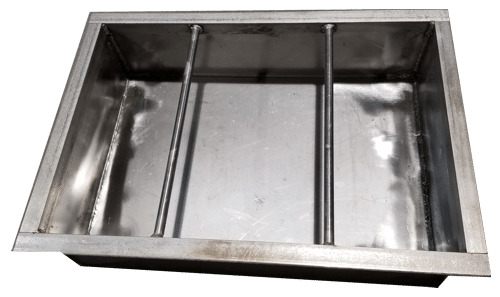
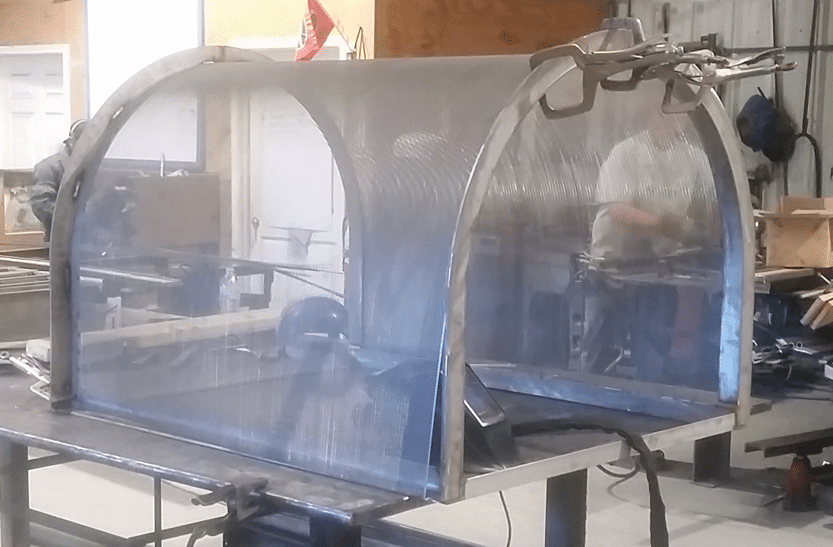
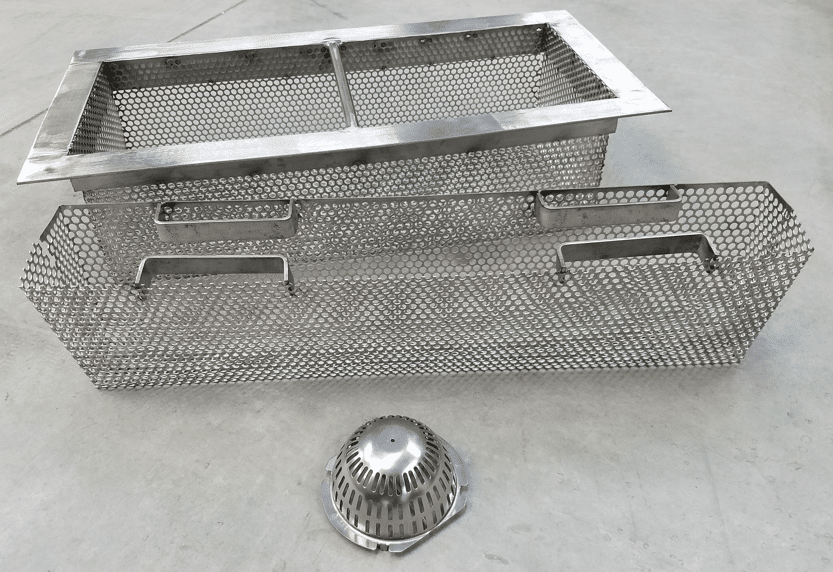
Selecting between a Trash Basket or Sediment Bucket
The first thing that should be considered is what are you trying to capture….debris or sediment? If you are capturing debris that is floating you will want a trash basket. These capture everything from grass clippings to bottle tops to animal hair. The smaller the object being collected the smaller the holes will need to be. There should be a balance though. Smaller holes tend to plug and blind. Smaller holes will need more frequent cleaning. The holes should be as large as possible while still protecting the piping system from excess debris and clogging. DuraTrench offers two standard size holes – 1/4″ and 1/8″. It is important to note that we have provided many other size holes upon request. We have provided holes as large as 1″ and down to mesh sizes for things like DE (diatomaceous earth).
A trash basket typically has the piping located such that all of the liquid must pass through the basket before entering the pipe. This ensures that all liquid is screened through the basket.
If sediment is being collected a Sediment bucket is in order. These are solid buckets that sit on the bottom of the basin. This material is typically a suspended solid that will fall to the bottom as the flow slows or over time. This can be dirt from a parking lot to stone dust in a counter top manufacturing facility. Because these buckets are solid the pipe is placed above the basket. The volume below acts to create laminar flow which settles out the suspended solids. It is best to place the outlet pipe across from the inlet versus on the side. This gives maximum time in the laminar area to remove a maximum volume of solids. The longer the laminar flow section the more likely the solids are to fall out into the bucket. Note that a longer basin with multiple buckets may be required to properly remove the sediment.
Wet material can be very heavy. Be sure to think about how to lift the basket or bucket. Large size baskets may need to be lifted with a piece of equipment. A good rule of thumb is that a cubic foot of wet material may weigh upwards of 150 lbs per cubic foot.
No matter what is going into your system, we can design a trash basket, sediment bucket, screen or strainer to fit your needs. We have built hundreds of custom baskets of all kinds to fit the most obscure needs. While we recommend our standard basket design, if you need something special please don’t hesitate to ask.
Proper design of a trash basket
A proper trash basket design will not allow water to short circuit or pass through the system without going through the basket. Over the years we have seen many ineffective baskets that were not properly sized or seated in the basin. This can allow debris to bypass the basket. The Dura Trench trash baskets are fit tight to the edges of the basket or sit on a frame to ensure a full seal. This ensures that everything gets screened before entering the underground system.
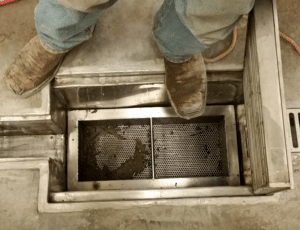 The best designs keep the baskets suspended off the bottom of the drain. Baskets that sit directly on the bottom or flush with the walls of the drain blind and plug. This reduces flow rates and can make the whole system ineffective.
The best designs keep the baskets suspended off the bottom of the drain. Baskets that sit directly on the bottom or flush with the walls of the drain blind and plug. This reduces flow rates and can make the whole system ineffective.
Trash baskets and especially sump boxes will be in constant contact with wet and sometimes corrosive materials. The basket material should be strong and corrosion resistant. For this reason, DuraTrench always uses stainless steel for baskets and strainers. Other materials like steel and even galvanized steel have a very limited life and should be avoided.
Because the wet debris gets very heavy you will want a basket that is structurally robust. If the basket is built from flimsy materials it will fail in short order. Many plastic baskets have broken handles due to lifting heavy wet materials on a regular basis. We build ours from strong, durable stainless steel to ensure that our trash baskets last.
Maintenance considerations
When deciding on the proper trash basket, sediment bucket, or strainer the maintenance should be considered. The size of the basket should be evaluated with regard for the weight. If you will be emptying the basket by hand we recommend the basket is no more than 1/4 of a cubic foot (about 35 lbs). On large basins this may mean multiple baskets or buckets. If lifting with a machine, ensure the handles or lifting hooks are strong and secure for safety. Also, make sure access can be maintained for equipment to reach the baskets/buckets.
While considering maintenance there is a fine line between the weight and frequency of cleaning. The larger the basket the less often it must be emptied. Unfortunately, the larger the basket the more it will weigh. Finding the proper cleaning frequency is important. Try to size the basket for at least a single shift or to coordinate with typical cleaning cycles.
